This post gives an overview of the most common spiders in Australia. They are categorized into dangerous and not dangerous spiders. Please keep in mind that the large majority of all spiders around the world and even in Australia are harmless for humans and pets.
Table of Contents
Not Dangerous Spiders of Australia
All spiders can and will bite if in danger or accidentally touched e.g. in shoes or clothing etc. Any spider bite can cause a reaction, ranging from a bee or wasp sting type bite to those requiring hospitalisation. Different people react in different ways, so if you see a spider it is best to be cautious and look but do not handle any spider no matter how it is classified.
Orb Weavers
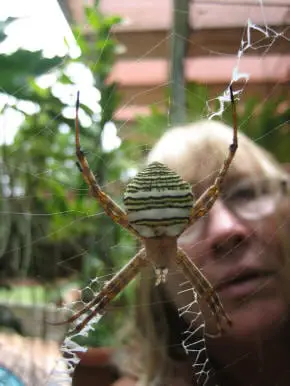
St Andrews Cross Spider: Argiope mangal
These spiders get their name for the way their hold their eight legs in pairs to form an X shape. The X is called the St. Andrew’s cross because it is believed that the saint was martyred on a cross of this shape rather than the conventional + shape. Besides their standard orb-web, Argiope spiders build additional white opaque zig zag lines on their webs, called stabilimentum. Sometimes the zig-zag lines match their leg positions, which lead some people to suggest that this helps give the appearance of longer legs. Some spiders build a single vertical line, yet others a patch of zig zags in the centre of the web. No matter the design, the spider sits right smack in the middle. The bite of this spider is considered harmless or at most to cause a weak local reaction. Few bites have been recorded.
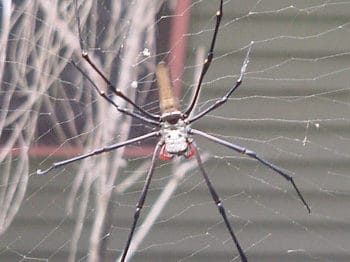
Golden Orb Weaver – Araneidae, genus Nephila
This species is especially large and spectacular and is well known from tropical north Queensland, Papua New Guinea and the Pacific. There is a report of this species laying her eggs in soil. Males are much smaller, about 6mm in body length, and will often be somewhere in her web and at other times even clambering on her body. They are called golden orb weavers after their web which has a golden colour and is remarkably strong. It has a characteristic yellow colour as does the fluffy egg sac which tends to be left in the tree the spider was using for support.
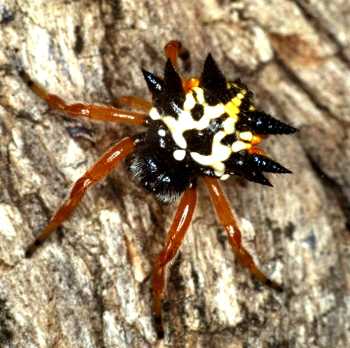
Jewel Spiders – Gasteracantha Minax
They are also known as spiny orb weavers and are part of the orb weaving spider family. This spider’s body is very broad and grows to the size of a 20c piece, with its 8 legs being the length of a pin (fairly short for a spider). Its abdomen is strikingly coloured with bright yellow and white and black. Six stout spines (long and sharp) come from the border of the abdomen.
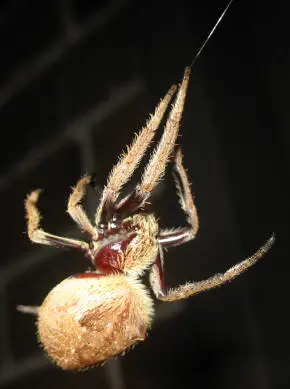
Garden Orb Weaver – Araneus diadematus
The family is a large one, including over 2800 species in over 160 genera. New species are still being discovered. Orb weavers (Araneidae) are often brightly coloured with rounded abdomens, some with peculiarly angled humps or spines. However, there is considerable variation in size, colour and shape in this group. They are often recognized for building beautiful, large, round webs, on which they rest, head downward, waiting for prey. The webs consist of a number of radiating threads crossed by two spirals. The inner spiral begins in the centre, winds outward, and is made of smooth threads like the radiating threads. It covers only the central 1/3 of the web. The outer spiral begins at the edges and winds inward. It is made of more elastic, sticky threads, coated with a liquid substance.
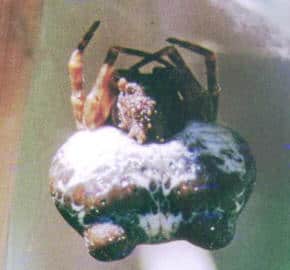
Bird Dropping Spider
Other names for this spider are the Death’s Head Spider, as its markings can also resemble the shape of a skull, and the Orchard Spider, because it is often seen on fruit trees where moths, its main source of food, may be abundant. The Bird-dropping Spiders are found throughout much of eastern and southern Australia and have even been recorded from Uluru in central Australia. They are moderately common in suburban gardens but often overlooked. The abdomen of the Bird-dropping Spider (Celaenia species) is broad and triangular in shape, concave along midline, and has a pair of roughened humps towards the rear. The legs are usually held folded against body. The body size is about 12 mm (female) and 2.5 mm (male). At night, the spider hangs from the edge of a leaf or twig on a short silk thread, its forelegs outstretched. The bite of this spider is not considered to be dangerous. Usually no treatment is required. A cold pack can be applied to help reduce any pain or swelling at the site of the bite.
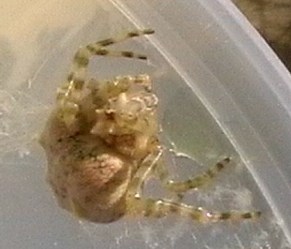
Araneus Orb Weaver
Generally, orb-weaving spiders are three-clawed builders of flat webs with sticky spiral capture silk. The web has always been thought of as an engineering marvel. It is build by the spider starting with a line floated on the wind to another surface. The spider secures the line and than drops another line from the centre, making a “Y”. The rest of the scaffolding follows with the radii of non-sticky silk being constructed before the final spiral of sticky capture silk. The third claw is used the walk on the non-sticky part of the web. Characteristically the prey insect that blunders into the sticky lines is stunned by a quick bite and then wrapped in silk. If the prey is a venomous insect, such as a wasp, wrapping may precede biting.
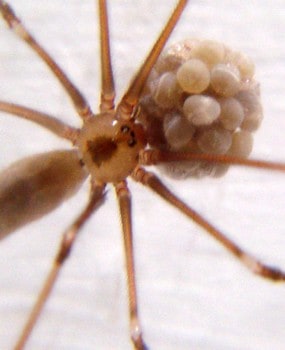
Daddy Longlegs – Pholcus phalangioides
Pholcid spiders are araneomorph spiders which kill and digest their prey using venom. However there is no scientific basis for the urban myth that daddy-long-legs are the most venomous, poisonous or toxic spiders in the world. Daddy-long-legs spiders have venom glands and fangs but their tiny fangs are fused at the base and while commonly thought not to bite humans, have been reported as doing so. Their venom has not been studied in detail.
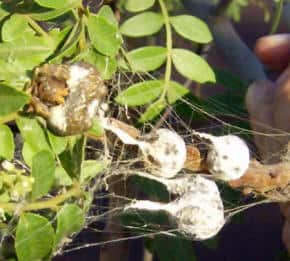
Bolas Spider Mastophora cornigera
The female Bolas spider is inactive during the day, although she can often be found in fairly exposed places. The male is much smaller than the female. Shortly after dusk, the spider lowers herself on silk threads, spins a silk line with a sticky blob on the end of it and swings it to catch the moths or other insects that have been attracted by chemicals. The spider gets its name from the bolas (ball-on-a-string) weapon used by Eskimos and South American Indians.
Hunting Spiders
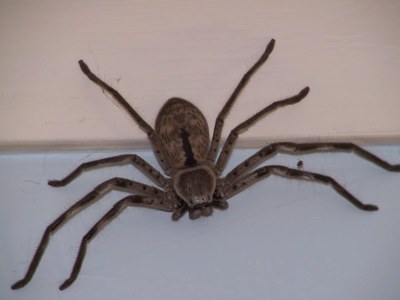
Huntsman Spider
Huntsman spiders are those long-legged spiders we often surprise crawling around our ceilings at night. They are part of the “modern” spider species which breathe through trachea as well as through “book-lungs”. They also have chelicerae which close side to side. The legs of a huntsman spider fan out sideways and the joints bend forwards. This means these spiders can run sideways as well as forwards – useful under bark and among stones.
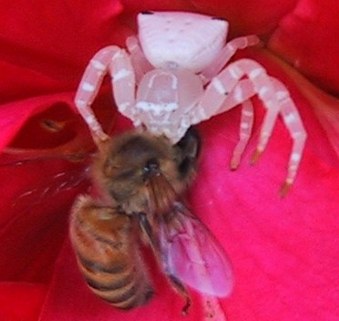
Flower Spider – Thomisus spectabilis.
Another name for the Flower Spider is the Crab Spider because it has white or yellow stout legs which are held like a crab. The full size of the Flower Spider is between four and ten millimetres. Flower Spiders are often white or yellow in colour, some have green, brown or rosy tints on the abdomen. The females are small and their legs are less than 7mm long. The males are even smaller, but their legs are longer. They normally have two large front eyes and have very well developed eyesight.
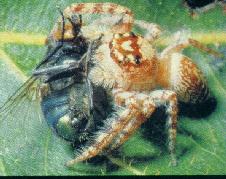
Jumping Spider – Opisthoncus
The Jumping Spider is a diurnal animal with excellent eyesight, that pursues its prey and leaps upon it. It has an all-round view of its surroundings because of its large, central, front eyes. It is about the size of a 20c piece when fully grown, with pin size legs. There are many different species but all jump and turn their heads separately from their bodies to look at objects. They live in houses and gardens and are most common in Summer, Australia wide. It is a roving spider but hangs from web lines at night. It rarely bites people and causes only mild local pain.
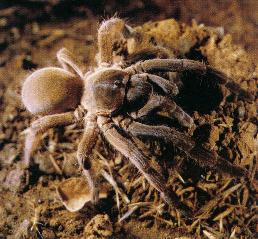
Trapdoor Spider
Trapdoor spiders can be distinguished from the more dangerous Funnel web spider by its brown or mottled markings. When in danger, a Trapdoor spider will freeze or flee whereas a Funnel web will rear back aggressively. A Trapdoor spider has smaller spinnerets than a funnel web. Trapdoor spiders are not particularly harmful to man however, like Tarantulas, the tiny hairs on the legs of some species leave tiny red marks where the “toothed” hairs on the spiders’ feet have clung to the skin.
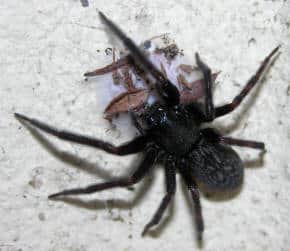
Black/Brown House Spider
Adults are about 15 mm in body length and of a dark brown to black velvet textured appearance. The carapace and legs are dark brown to black, and the abdomen is charcoal grey with a dorsal pattern of white markings. It spins a lacy, messy web and prefers dry habitats in secluded locations. It is commonly found in window framing, under eaves, gutters, in brickwork, sheds, toilets and among rocks and bark. Electric lights attract their prey – moths, flies, mosquitoes and other insects. Its bite is poisonous but not lethal. Certain people bitten experience severe pain around the bite site, heavy sweating, muscular pains, vomiting, headaches and giddiness. First aid and medical attention (ambulance) should be sought as soon as possible.
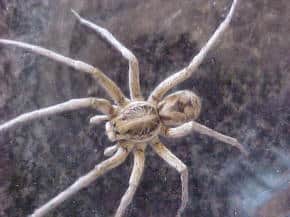
Wolf Spiders – Lyosidae, Genus Lycosidae
The Wolf Spider got its name because it stalks its prey like a wild dog. It is an open range hunting spider. The female grows to 35mm and the male to 20mm. They are a small to medium size spider. They can be grey or brown with marking on their back which can be black, orange, grey or brown. The Wolf Spider has three rows of eyes, two at the back, two in the centre and four in the front. The Wolf Spider is not an aggressive spider. If the spider is handled, it can cause a painful bite which may cause infection and skin lesions to some people. Females carry their babies on their backs.
Dangerous Spiders in Australia
The spiders listed below have been known to cause death or give bites that are classed as dangerous or life threatening. However, there is an antivenin available for the Black Widow which is the spider most likely to have caused deaths in the United States.
Dangerous Web Spinning Spiders
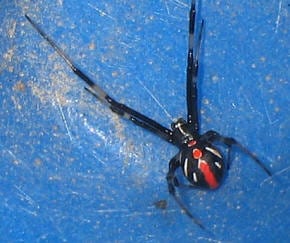
Redback Spider – Lactrodectus hasselti
The Red-back is found in all parts
of Australia except in the hottest deserts and on the coldest mountains. It is the only dangerous spider with an Australia-wide distribution. Red-backs are very common in Summer. The female Red-back has a spherical satin-black abdomen with an orange-red stripe. The abdomen is usually about 1 cm in diameter. Its bite can cause serious illness and deaths used to occur before an antivenom became available in 1956.
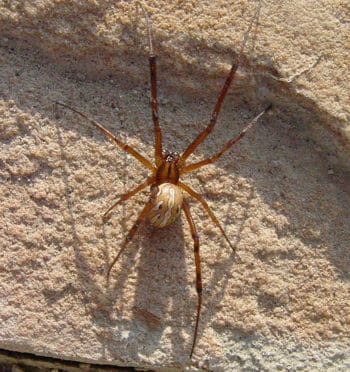
Brown Widow – Lactrodectus geometricus
The Brown Widow is of the same group as the Red-back and the Black Widow but its toxin is about one-tenth the strength of the Red-back toxin and does not cause the same severe reaction. It can be a garden pest of plague proportions.
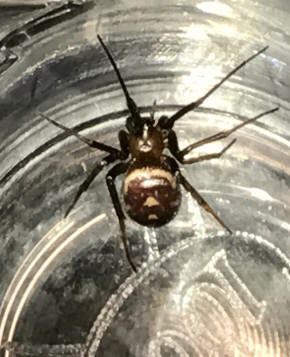
False Widow – Steatoda grossa
Steatoda grossa, commonly known as the cupboard spider, the dark comb-footed spider, the brown house spider, or the false widow, is a common species of spider in the genus Steatoda. It is a cosmopolitan species found in many parts of the world, including North America, Australasia, and Europe.
Hunting Spiders
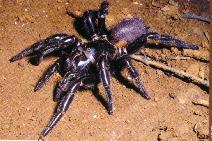
Sydney Funnel Web Spider – Atrax & Hadronyche
The Sydney Funnel-web Spider is believed to be limited to an area of about 160 kilometres from the centre of Sydney. Other species of Funnel-Web Spider are found in Eastern Australia, Victoria, South Australia and Tasmania. They are probably the most venomous aggressive spider in the world, all funnel web species should be treated as dangerous, not just the Sydney or Northern tree dweller. However, species proven dangerous to humans are largely limited to eastern parts of NSW and SE Queensland. The only proven killer, Atrax robustus, is restricted to the Sydney region and adjacent areas to the north and south of the city, including Gosford. If they bite you it is usually a pretty deep injection but even a small grazing bite means get to hospital immediately.
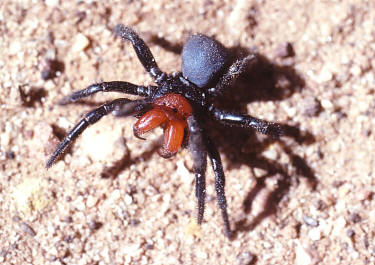
Red Headed Mouse Spider – Missulena Occatoria
This is the Red Headed Mouse Spider. At full size, the Mouse Spider are about the size of a 50c piece or 1 to 3 centimetres. They have short stocky legs with tiny eyes spread across the head. They have been known to cause severe illness, especially to young children – similar to Red-Back Spider. Although normally not aggressive, the male mouse spider will bite if provoked, and should be considered dangerous to humans. It has large hard fangs which can cause a deep painful bite.
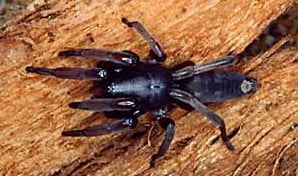
White Tailed Spider – Lampona cylindrata
The white tailed spider is about the size of a 50c piece when fully grown, with a leg diameter about the size of a pin. It has a grey cigar-shaped abdomen with a white spot on the end and sometimes the legs
are banded with light traverse marks on the abdomen. These markings are more predominant on the juvenile White Tailed spider. It is typically found in cool, dark areas – under bark, in gardens, litter, walls and beds. It is active at night time. Although it has been suggested as a culprit in rare cases of large scale necrotic lesions,
there is little supporting evidence.
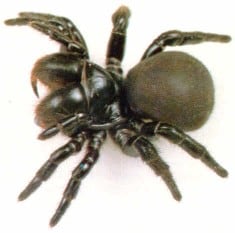
Eastern Mouse Spider – Missulena Occatoria
The Mouse Spider is a member of the Trapdoor family. There are two types of Mouse Spider – the Red Headed Mouse Spider and the Eastern Mouse Spider. At full size, the Mouse Spider are about the size of a 50c piece or 1 to 3 centimetres. They have short stocky legs with tiny eyes spread across the head. They have been known to cause severe illness, especially to young children – similar to Red-Back Spider. Although normally not aggressive, the male mouse spider will bite if provoked, and should be considered dangerous to humans. It has large hard fangs which can cause a deep painful bite.
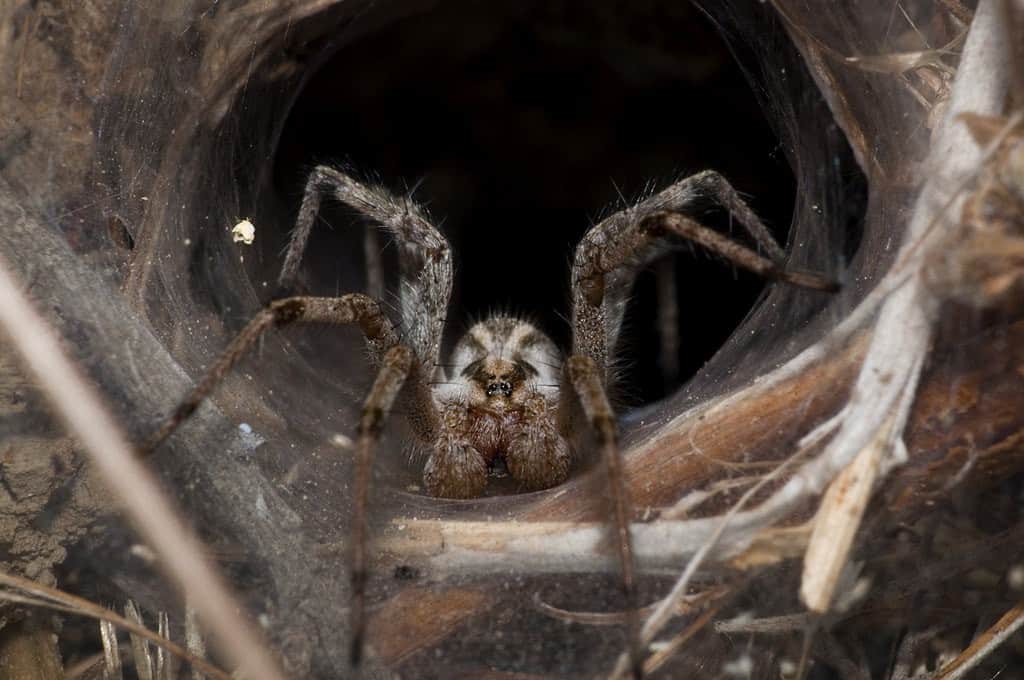
Other Funnel Web Spiders
There are approximately 40 other funnel-web spiders – none as venomous as the dreaded Sydney funnel-web. In fact, only six have been proven to pose a threat to safety. Two of the most dangerous include the northern tree funnel-web spider (hadronyche formidabilis) and the southern tree funnel-web spider (hadronyche cerberea). Although numerous bites are reported each year, with victims generally residing in Southern Queensland or Northern New South Wales, the anti-venom has proven hugely effective.
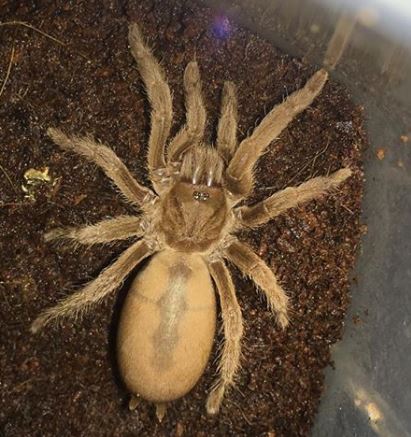
Australian Tarantula
The indigenous Australian tarantula is found countrywide and covers four dominant genera – – Selenocosmia, Selenotholus, Selenotypus, and Phlogiellus. Although only six species are recorded, it is thought many more are undiscovered. With a large frame, sharp fangs and characteristically long and hairy legs, Australian tarantulas are certainly a sight to be reckoned with. However, they do not pose such a severe threat to humans; their bites are known to be painful yet unlikely to cause lethal effects.
